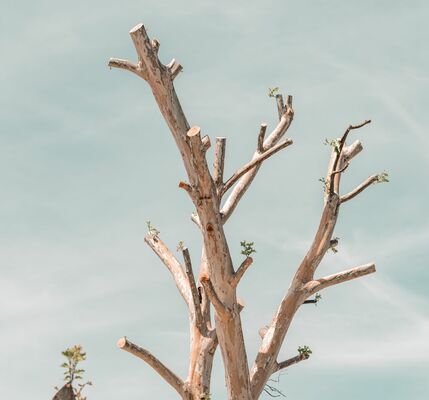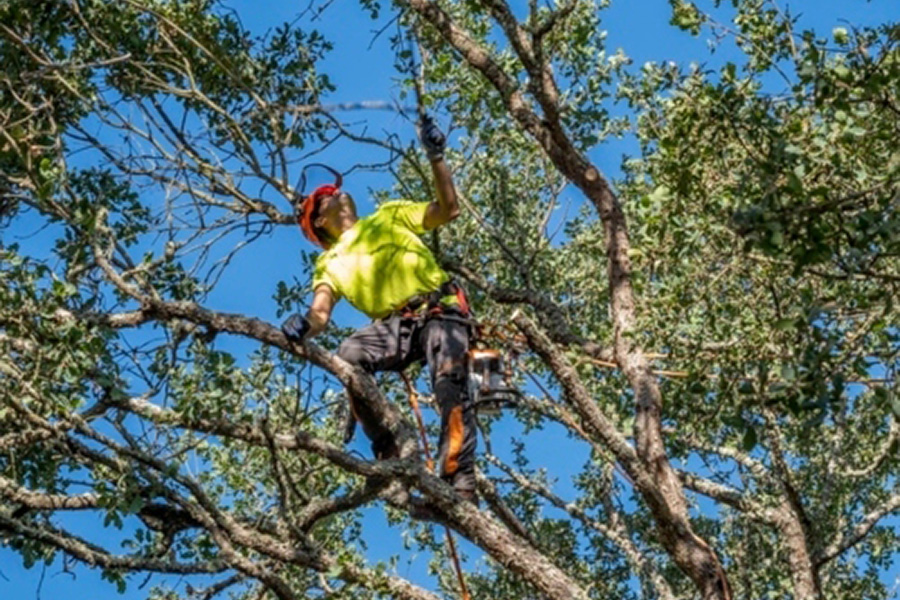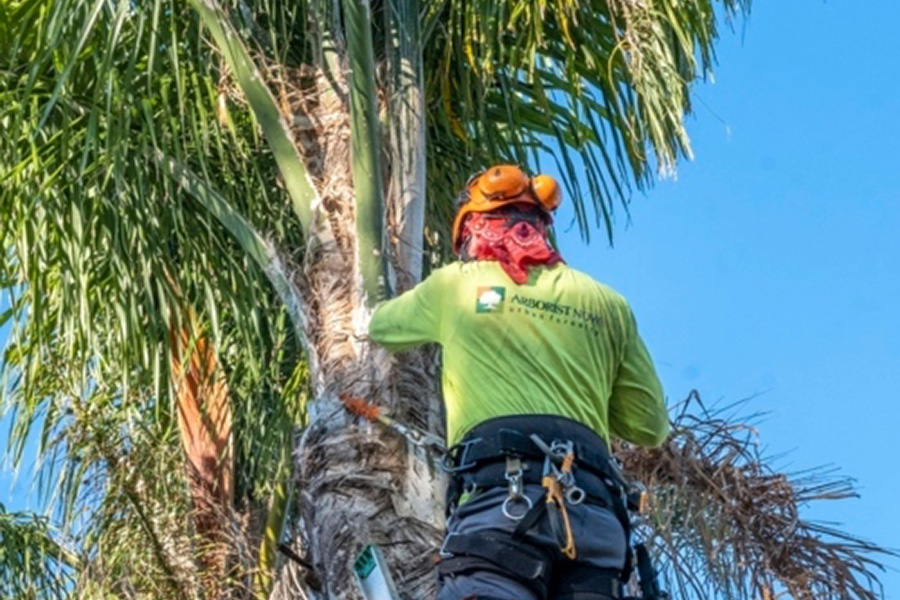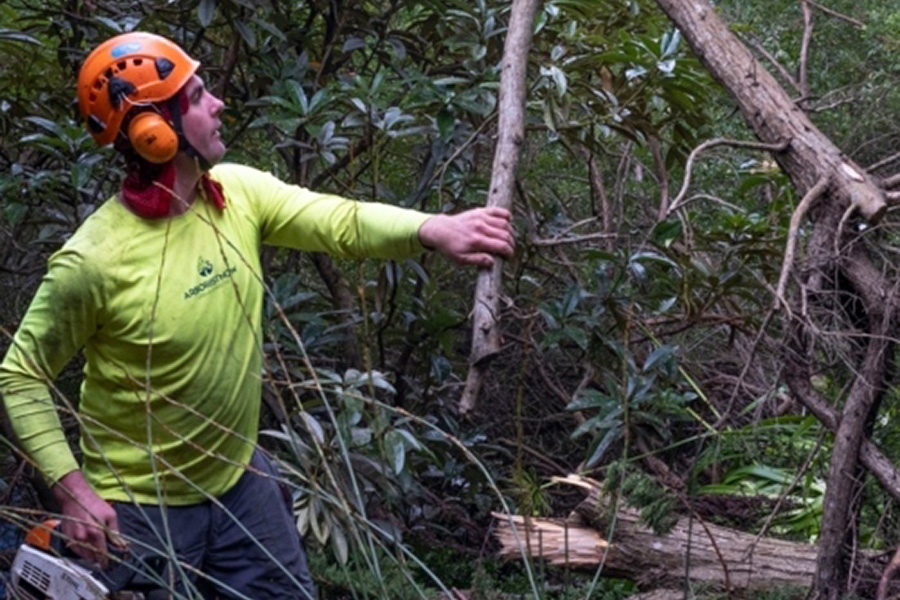The Trouble with Topping Trees

Trees are remarkably resilient organisms.
Because they compartmentalize, or seal off, their wounds, skilled arborists can prune trees to improve their health, alter their structure, or improve fruit and flower production. As long as the arborist does not remove too much of the canopy, and they place cuts in the right locations, the tree is unlikely to suffer.
However, improper pruning practices can weaken even the healthiest specimens. In especially tragic cases, improper pruning can lead to the tree's premature demise. Such is often the case whenever trees suffer a particularly contentious pruning practice called “topping."
What Is Topping?
A Tree Care Professional Carefully Pruning Branches
Topping is an aggressive pruning method where the upper main branches of a tree are removed, often leaving behind stubs or lateral branches that are too small to assume the role of a terminal leader. This practice results in an unnatural and often unsightly appearance. The goal is typically to reduce the height or spread of a tree, but it often leads to more problems than it solves. Topping can be seen frequently in urban areas where trees grow too close to utility lines or structures, but its negative impacts far outweigh any perceived benefits.
Topped trees lose their natural form and beauty, which can detract from the landscape's aesthetic value. The cuts made during topping are usually large and not near the natural branch junctures, making it difficult for the tree to heal properly. This can lead to a range of health issues for the tree, potentially shortening its lifespan significantly. Understanding the implications of topping is crucial for anyone considering this practice as a solution to tree management problems.
Problems Caused By Topping Trees
A Skilled Arborist Now Employee Cares for a Tropical Tree
Topped trees certainly compromise the aesthetics of the tree and the surrounding area, but the technique causes a variety of other problems for the tree as well.
Nutrient Starvation
One of the most significant issues with topping is the removal of too much of the tree's canopy. Trees rely on their leaves for photosynthesis, the process by which they create food. When a large portion of the canopy is removed, the tree struggles to produce sufficient food, leading to nutrient starvation. This can weaken the tree and make it more susceptible to diseases and pests. Furthermore, the loss of canopy can cause stress to the tree, manifesting in reduced growth and vitality over time.
The reduction in leaf area also impacts the tree's ability to cool itself through transpiration, exacerbating stress during hot weather. This physiological imbalance can lead to long-term decline and even the premature death of the tree. It is important to maintain a healthy canopy to ensure the tree's survival and well-being.
Sunscald
Drastic alterations to a tree’s canopy may expose formerly shaded areas to the sun, leading to a condition known as "sunscald" or "southwest injury." This issue is particularly harmful for tree species with thin bark, such as maple, birch, and ash trees. Sunscald occurs when the tree's bark, previously protected by the canopy, is suddenly exposed to direct sunlight. This can cause the bark to heat up during the day and cool rapidly at night, resulting in cracks and lesions that can severely damage the tree's vascular system.
The consequences of sunscald can be long-lasting, as the damaged bark becomes an entry point for diseases and pests. Over time, repeated sunscald injuries can weaken the tree, making it more susceptible to decay and structural failure. Preventative measures, such as proper pruning techniques that avoid sudden exposure of shaded bark, are crucial to maintaining tree health.
Increased Vulnerability to Pests and Disease
Topping often leaves large, open wounds that are slow to heal. These wounds can become entry points for insects and pathogens. Trees naturally compartmentalize wounds to protect themselves, but the size and location of cuts made during topping can overwhelm this defense mechanism. As a result, topped trees are more likely to suffer from infestations and infections that can spread to the rest of the tree, further compromising its health.
Insects like bark beetles are particularly attracted to stressed and weakened trees, which are common outcomes of topping. These pests can introduce diseases such as Dutch elm disease or oak wilt, which can devastate tree populations. Preventing topping can help maintain stronger, healthier trees that are better equipped to resist these threats.
Weak Branch Attachments
In response to the loss of their canopy, topped trees often produce a flush of new shoots, known as watersprouts. These sprouts grow rapidly but are weakly attached to the main branches, making them prone to breaking. As these new branches grow larger, they become increasingly hazardous, posing a risk to people, property, and the tree itself. The weak attachment points can fail under the weight of the new growth or during storms, leading to potentially dangerous situations.
Over time, these weak branches can compromise the structural integrity of the tree, increasing the likelihood of limb failure. Regular monitoring and maintenance are required to manage this risk, which can be both time-consuming and costly.
Long-Term Maintenance Issues
Topping is not a one-time solution but a practice that creates a cycle of maintenance issues. The rapid growth of weakly attached branches requires frequent pruning to manage the tree's shape and safety. This ongoing maintenance can become a significant burden for property owners both financially and in terms of time commitment. Furthermore, repeated topping can further weaken the tree, perpetuating the cycle of decline and increasing the likelihood of tree removal.
Choosing proper pruning techniques and preventative measures can save resources and maintain the health of the tree. Professional arborists can provide guidance on sustainable tree management practices that avoid the pitfalls of topping.
Sensible Solutions
One of Arborist Now's Experts Examines Broken Branches
Right Tree, Right Place
The primary reason trees are subjected to topping is that they have grown too tall for the space in which they were planted. One of the best ways to avoid the need for topping is to plant the right tree in the right place. Before planting a tree, consider its mature size and growth habits. Choose species that will fit comfortably within the space available, considering both height and spread. This foresight can prevent conflicts with utility lines, buildings, and other structures, reducing the need for drastic pruning measures.
By selecting appropriate tree species and planting locations, you can ensure that your trees will grow healthily without requiring excessive intervention. While skilled arborists can safely reduce the height of some trees, the best solution is to plant suitable species for the location. By planting trees that reach only modest heights in such places, you can alleviate the need for such drastic and destructive pruning practices. Consulting with an arborist can help you make informed decisions about tree selection and placement.
Alternative Pruning Techniques
There are several pruning methods that can help manage the size and shape of a tree without resorting to topping. Crown reduction, for instance, involves selectively removing branches to reduce the tree's height and spread while maintaining its natural form. Thinning cuts can also be used to reduce canopy density, allowing more light and air to penetrate through the tree, promoting overall health.
Proper pruning techniques should always aim to preserve the tree's structural integrity and health. Hiring a certified arborist to perform pruning can ensure that cuts are made correctly and strategically, minimizing harm and promoting the tree's long-term well-being.
Topping is illegal in the city of San Francisco. Do your part to end the practice by reporting trees that have been topped.
Topping is a harmful practice that should be avoided. By understanding the negative impacts of topping and adopting sensible tree management practices, we can ensure that our trees remain healthy, safe, and beautiful.
If your trees are rapidly outgrowing their surroundings, o ur skilled arborists can examine the tree and recommend a suitable approach for resolving the problem. Alternatively, if you are interested in planting new trees, our arborists can help you determine which species will stay small enough for the spot available. Contact us today to get started!
Originally published on May 19, 2016.








